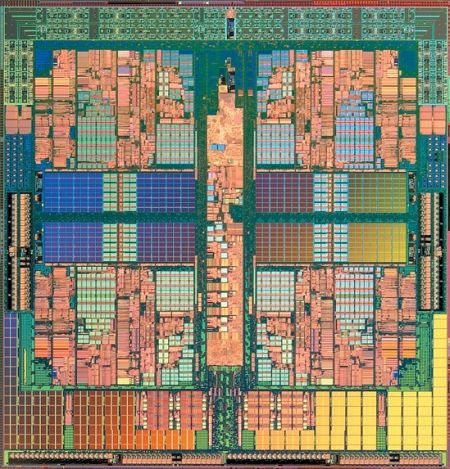Phenom 9700, AMD's 1st Quad-Core CPU
The Phenom In Detail - A Revamped Athlon 64
AMD has thoroughly reworked the core of the Phenom processor compared to the Athlon 64, succeeding in raising the number of instructions per clock cycle (IPC). According to AMD, we should expect to see a performance increase of up to 25% at the same clock speed.
Like several of the later Athlon 64 models, the Phenom is manufactured on a 65 nm production process. In its presentation, AMD stated that it will begin transitioning to a 45 nm process starting in 2008. Unlike Intel's quad-core solutions, which consist of two dual-core processors combined in one CPU package, AMD's Phenom uses a single die comprising four cores. The resulting die has an area of 285 mm² and consists of 600 million transistors. That means that the transistor count has more than doubled compared to the Athlon 64 X2, which consisted of 227 million transistors.
The BIOS POST message
The downside to the single-die quad-core approach is a greater risk of manufacturing defects and thus lower yields. If even one of the cores suffers a manufacturing defect, the entire quad-core CPU becomes defective. AMD has found a solution, if this should ever happen, though. If one of the cores is indeed defective, it is deactivated, and the processor is sold as a three-core model. In an interview in Warsaw, AMD now officially confirmed that the tri-core models are indeed quad-cores with one deactivated core. In the end, this is a boon to the consumer. Where Intel would sell a processor with one defective core in the notebook sector, since the desktop line does not include a single-core Core 2 processor, AMD's customers will be able to purchase an inexpensive tri-core CPU. However, for now it is unclear when the Phenom X3 processors will go on sale.
Stars Core Micro-Architecture
While AMD's quad-core processor was still in development, the new micro-architecture was referred to as K10. Now, with the official introduction, it is being rechristened the Stars core micro-architecture
The last time AMD introduced a completely new micro-architecture was in September of 2003 with the launch of the Athlon 64. During the long development time for the Phenom processor, a great number of alterations were made to the core design, resulting in a performance increase at the same clock speed.
Get Tom's Hardware's best news and in-depth reviews, straight to your inbox.
A block diagram of one of the four Phenom cores.
Current page: The Phenom In Detail - A Revamped Athlon 64
Prev Page Top Model With Four Cores - AMD Phenom 9700 Next Page Technology I - Advanced Memory Prefetcher, SSE4aTom's Hardware is the leading destination for hardcore computer enthusiasts. We cover everything from processors to 3D printers, single-board computers, SSDs and high-end gaming rigs, empowering readers to make the most of the tech they love, keep up on the latest developments and buy the right gear. Our staff has more than 100 years of combined experience covering news, solving tech problems and reviewing components and systems.
-
spearhead good review but you should have had included more result of the overclocked phenom. i just want to know how much juce i you can push out of it for me it is a must it beats the 6400+ otherwise its not worth purchasing in my opinion, it just has to beat its older generation when its running at same clocks.that is why amd has to work on its clock speed and cache. hopefully deneb will be out soon. i would also realy appriciate it to see some review about the phenom 9850 black edition compared against both the 6000+ 6400+ and q6600 and q9300 and maybe some e8xxx model. with overclocked results. pushed it to the maximum. would be realy cool hehe :)Reply -
haifen The SB700 does indeed support at least one PATA port as my motherboard has an IDE connector and I can use it with the ATIIXP PATA driver.Reply



